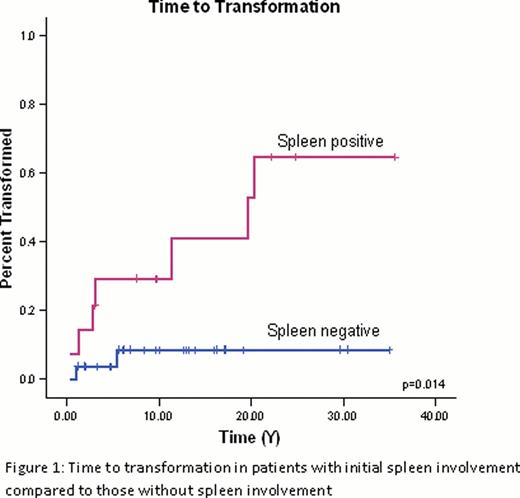Abstract
Abstract 1531
Nodular lymphocyte predominant Hodgkin lymphoma (NLPHL) constitutes 5% of all Hodgkin lymphoma (HL), and with only 20% presenting with advanced stage, there are limited data regarding the optimal management and long-term outcome. We previously reported a moderate risk of transformation to NLPHL to aggressive lymphoma evaluating all stages and advanced stage disease and spleen involvement emerged as risk factors (Al-Mansour et al., JCO, 2010). Herein, we evaluated the outcome and transformation risk of advanced stage NLPHL (stage IIB, III or IV) and compared to a cohort of matched historical controls with classical Hodgkin lymphoma (cHL).
We screened the BCCA Lymphoid Cancer Database to identify all patients with NLPHL diagnosed between 1970 and 2011 by the WHO classification with prior pathological review. For each patient treated with curative intent (n=41), 2:1 matched controls with cHL were identified with matching by age (12–30, 31–45, 46–60, >60 y), gender, stage, decade of diagnosis, mass size (<10 cm or ≥10 cm) and treatment received. Lymphoma progression-free survival (LyPFS) was measured from the date of diagnosis to the date of lymphoma recurrence (NLPHL or transformation to aggressive lymphoma), or death due to acute treatment toxicity, HL or non-Hodgkin lymphoma (NHL). Freedom from treatment failure (FFTF) events included relapses from NLPHL and death due to acute treatment toxicity or HL. Overall survival (OS) and time to transformation (TTT) were as previously defined (Al-Mansour et al., JCO, 2010).
42 patients with advanced stage NLPHL were identified. Characteristics: median age 37 y; male, 71%; stage III disease, 90%; good performance status (PS≤1), 88%; non-bulky disease (<10cm), 100%. All cases had an IPSS score < 4, and 14 (34%) had splenic involvement. Most patients received ABVD-(like) chemotherapy (83%).
With a median follow-up of 10 y (range 1.2–35.6 y), the 5, 10 and 15 year OS were 89%, 86% and 76% respectively, and the LyPFS was 72%, 63% and 44% respectively. The FFTF, reflecting NLPHL relapses, at 5, 10, 15 years was 84%, 76% and 53%, respectively. In total, 20 (48%) patients relapsed with lymphoma. At first relapse, 12(60%) had NLPHL and 8 (40%), aggressive NHL. For the 12 NLPHL relapses, 1 later developed aggressive NHL, and 8 developed a second NLPHL relapse. In univariate analysis, poor PS (>2) was associated with a reduced LyPFS (p=0.042) and there was a trend towards excess relapses with spleen involvement (p=0.081). The median TTT was 5.45 y (range 0.3–20.3 y) and the risk of transformation at 5, 10, 15, 20 years was 12%, 15%, 20% and 30% respectively. The OS in ever-transformed versus never-transformed cases was 96% vs 67% at 5 y (p=0.123). Spleen involvement (25 y TTT 65% vs 8.5%, p=0.014, Figure 1) and mass size ≥5cm (p=0.003) at initial presentation were identified as risk factors for transformation. Risk factors for relapse with NLPHL were male sex (p=0.026), mass size < 5cm (p=0.038), and PS ≥2 (p=0.001) but notably, spleen involvement was not a risk factor (p=0.699). There was a trend towards increased risk of NLPHL relapse for patients receiving non-ABVD regimens (MOPP+/−RT n=3; RT n=2) (10 y FFTF 80% vs 17%, p=0.086).
For the matched control analysis, 82 patients with cHL were identified (80% NScHL), with a median follow-up time of 8.5 y (range 1.1 y – 26 y). Most cHL patients had an IPSS score < 4 (94%) and 41% had spleen involvement. The OS was similar in NLPHL and cHL (15 y OS 76% vs 67%, p=0.5808). There was a trend towards a superior LyPFS for patients with cHL vs NLPHL, 72% vs 44% at 15 years (p=0.096, Figure 2), respectively, but similar FFTF (p=0.930), reflecting an absence of transformation events in cHL. There were more late (> 5 y) lymphoma relapses in NLPHL (HL and NHL) compared to patients with cHL (45% vs 10%, p=0.01).
With long-term follow-up, almost half of the patients with NLPHL develop a lymphoma relapse and large proportion experience transformation to aggressive lymphoma. Splenic involvement is a strong risk factor for eventual development of aggressive lymphoma providing a rationale for CHOP +/− rituximab based chemotherapy. Although the OS of NLPHL is comparable to cHL, there is an inherent increased risk of transformation and late relapses, highlighting a distinct disease behaviour and the need for repeat biopsy at relapse as well as long-term surveillance.
No relevant conflicts of interest to declare.
Author notes
Asterisk with author names denotes non-ASH members.



This feature is available to Subscribers Only
Sign In or Create an Account Close Modal